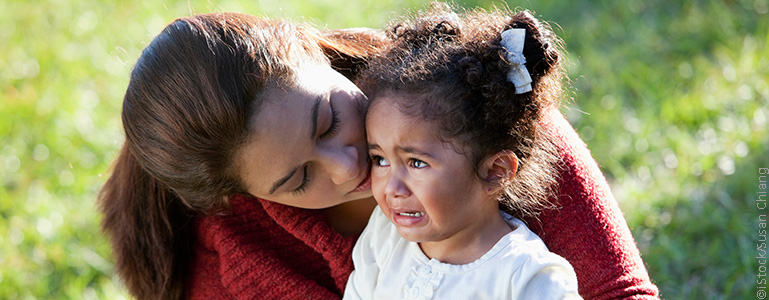Wild, wonderful and ever so challenging. The toddler set, those little ones under three, are delightful … cute and curious, learning so much, so quickly, and with sudden mood changes you wonder what entity took over your child’s body! You were once a great parent, and in the face of toddler meltdowns, whining, and irritability might wonder what happened to the confident, calm, loving parent you once were.
Tantrums are especially challenging at this age! Here are a few things to remember: your adorable child will return until the next unexpected melt down. And, you are not alone! Most parents of toddlers, at some point, feel similarly.
Managing Emotions
Your child’s body is learning to self-regulate. It takes time, actually years to attain. Limited language skills, egocentric perspective, and being driven by their own will, (often for the best intentions like safety!), create strong reactions in their bodies when thwarted. These strong feelings and reactions manifest in melt downs, and often physical behaviors like hitting or biting. Language skills are too new to access when strong emotions overtake your little one.
Here are some suggestions to help when in the throes of a tantrum, or even just managing irritability or whining:
- Identify the underlying cause: hungry, overwhelmed, tired, getting sick?
- Do not talk much … hum, sing softly, get eye contact if possible (don’t force it), touch
- Get close and on the child’s level
- Empathy—say simple things, “Wow, you have big feelings about that.” “It is hard not to have X now.”
- Add some imagination—“I wish I had a magic wand to wave and you could have six trains all to yourself”.
- If s/he is hurting herself or you in some way, gently stop it (block the hand, etc.). “It’s okay to be mad. And no one gets hurt with your anger. We are all safe here”.
- Some things that help to bring calmness:
- Breathe in sync with your child, slowly slowing down.
- Touch or holding if s/he allows it
- Humming, softly singing, etc.
- Reassure—“Okay you have big feelings. It makes sense. I am here to help”. Do not talk a lot, just a little bit in simple language.
- When your child begins to calm, do not engage until s/he turns to you in some way … talks, looks, etc. This is the cue that s/he is ready for more input.
- Now help more by doing a trick related to sensory integration: Look up into a corner of the room and point, saying something like “Wow, do you see that spider there?” As child looks up, then point in another area of the room, “Oh, look, is there one in that corner?” Do this a few times. It neurologically helps to calm the body even more.
- Once calm, do not refer to the tantrum behavior or the trigger. Provide warmth and connection, and go on with your day. When it is over, it is over. They bounce back quickly … something we can learn from them!
Tantrum Prevention
- Rhythm and routine are important to this age child. Be consistent with meals, sleep times, etc.
- Being hungry, tired, not knowing what is happening next, too many transitions, going too fast for their pace is stressful for children. Identify your child’s triggers, and minimize them as much as possible.
- Transitions—provide as much information about transitions as possible. It is challenging for children to change what they are focused on, so advance information is useful. They cannot tell time, but saying, “We are leaving soon. You can slide three more times before we go.”
- Give your child some power within the context of your loving guidance. Offer choices that achieve your goal, “We can be horses and run to the car, or be birds and fly to the car?”
- Tell or show your child what s/he CAN do, rather what s/he cannot do. “You can jump on these pillows here. We are cozy and quiet in our bed.”
- Be playful—sometimes distraction or engagement in something interesting or pleasurable serves to distract from the conflict before it escalates.
- Choose your battles—Avoid power struggles. Your child will just get stuck there, as well as some of us big people! Make safety a priority, use distraction and playfulness to re-focus their attention, and eliminate potentially frustrating situations (close the bathroom door, move the cat food, etc.).
- Change things up when you suspect your little one is heading downhill—Connect, play, add water play or bubbles, etc. Sometimes hugging, swinging around and laughter is all that is needed to ward off a meltdown.
Need more advice managing your toddler’s big emotions? Our experienced parent coaches are here for you and your family, contact us today to get started.



